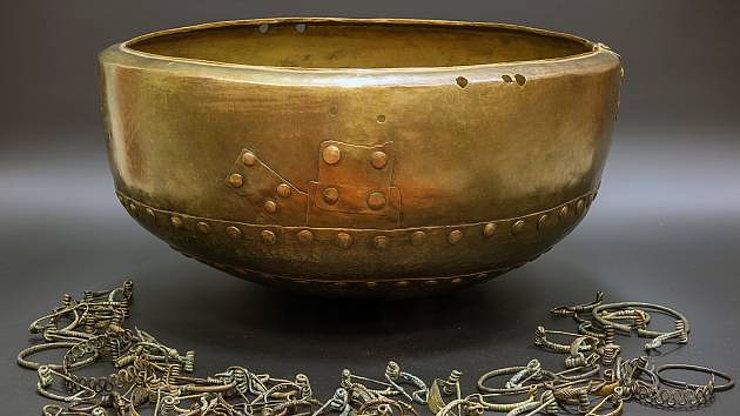Tak to je petelice.. 
12 February 1882 Celtic treasure from Lahost
Categories: Calendar

The so-called Lahošt' treasure is one of the rarest finds from the nineteenth century. In 1882 it was discovered by diggers one kilometre from Duchcov. Up to 4,000 jewels are said to have been found in the bronze cauldron, 1,600 have been confirmed.
The story of the discovery of the incredible Celtic treasure began in 1879, when the level of the mineral spring Giant began to drop dramatically. This was as a result of the disaster at the nearby Döllinger mine. As late as the mid-nineteenth century, the spring was still strong enough to power a water mill. The spring had to be deepened after the disaster at the mine.
The diggers started work in January 1881. When they reached a depth of six metres, they saw something incredible. A bronze cauldron about half a metre in diameter protruded from the gravel. The vessel was filled to the brim with jewels, bracelets, clasps and rings.
At that point, they were greenish from oxidation. But later, their value was appreciated by collectors who took the artifacts apart. Most likely, the jewels ended up there in private collections across Europe.
There are currently 573 clasps, 479 bracelets and 56 rings in our museums, most of which are owned by the Teplice Museum and Duchov Castle. Larger collections are still held by the National Museum and the Museum in Duchov. At least 105 clasps, fifty bracelets and ten rings are scattered in museums in Vienna, Berlin and London. A further 261 pieces of jewellery were found in various other museums. This was evident from the inventory sheets, which, however, were lost like most of the treasure found.
Only inaccurate accounts of the circumstances of the discovery have survived. "The number of objects recovered is nowhere recorded. We only know that most of the jewellery was in the cauldron and some of it was in the soil around it," noted Petr Budinský, an archaeologist at the Teplice Museum.
A material analysis was carried out last year by a team led by Alžběta Danielisová from the Prague Institute of Archaeology of the CAS. They found new information about the location of the treasure. The research was undertaken because they were investigating the circumstances surrounding the migration of the Celts.
"We thought about the objects that are most likely to have travelled with humans. Personal items, preferably items of clothing, come directly to mind in this context. For comparative analysis, we used for the first time ever artefacts from the famous find from the thermalspring near Duchcov, as well as jewellery from contemporary Latin burial sites," Danielis said.
The scientists found that bronze alloys, used for the production of jewellery and items of clothing, came fromcome from a number of geographically distinct sources, for example, from as far away as modern-day Switzerland. This suggests that the communities involved in the hoard came from different parts of Europe. The long-debated question of whether the Celts migrated en masse can thus finally be answered.
Sources: www.lahost.cz, https://sciencemag.cz/, www.denik.cz
The article is included in categories:
Post
No jestli to fakt tahle někdo očistil měly by mu useknout ruce 




Tedy Marku, překvapuješ 
Nedávno jsi v diskuzi tvrdil že nález většinou nic neprokazuje a tudíž neodevzdávat a tady předkládáš vědecké poznatky 
Takže tady že se to dostalo do muzea je dobře?








